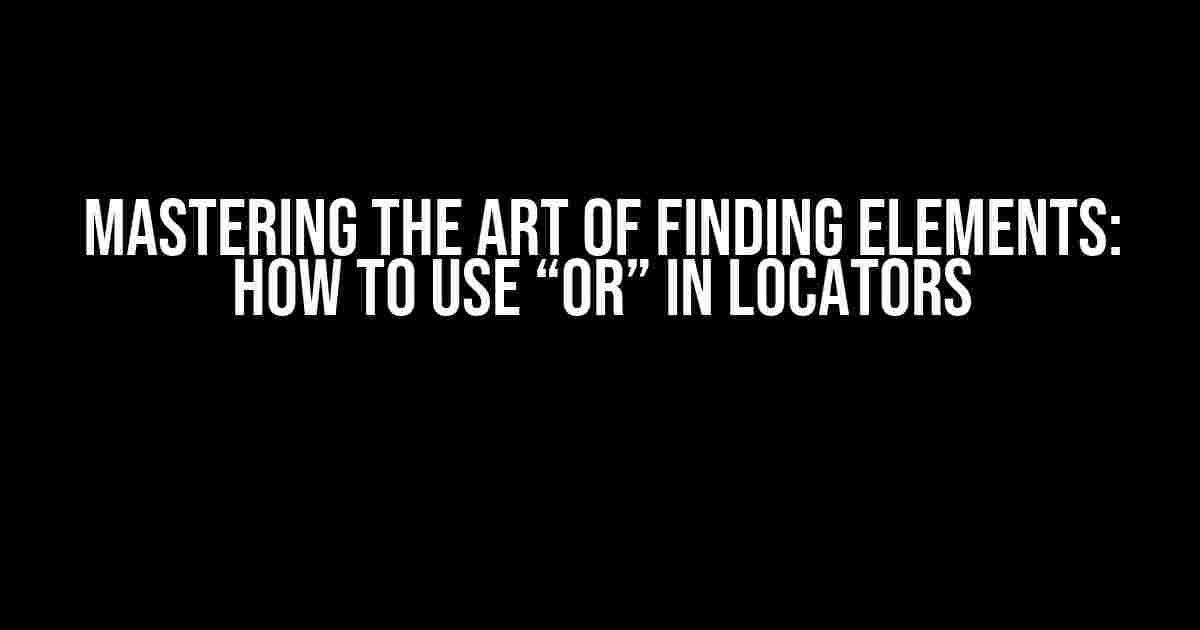Hey there, automation enthusiasts! Are you tired of dealing with complex and brittle locators that make your test scripts fragile and prone to failures? Well, you’re in luck because today we’re going to explore a game-changing technique that will make your element-locating skills shine like a pro – using “Or” in locators!
What’s the Problem with Traditional Locators?
Traditional locators can be quite restrictive, don’t you think? You’re forced to rely on a single, specific attribute or property to identify an element. But what if that attribute changes or isn’t always present? Your test script breaks, and you’re left scrambling to fix it. It’s like playing a game of hide-and-seek with elements, and it’s just not fun!
Enter the Hero: “Or” in Locators
Imagine having the power to specify multiple attributes or properties that can identify an element. With the “Or” operator, you can do just that! This magical operator allows you to combine multiple locators, making your scripts more flexible, robust, and efficient.
How Does it Work?
The “Or” operator is used to separate multiple locators. When you use “Or” in a locator, the automation tool will try to find an element that matches any of the specified locators. If an element matches one of the locators, it will be used; if not, the tool will move on to the next locator, and so on.
Example 1:
By.cssSelector("divclassed1 | div.classed2 | div#id123")
In this example, the automation tool will try to find an element that matches either of the three locators:
- Elements with class “classed1”
- Elements with class “classed2”
- Elements with ID “id123”
When to Use “Or” in Locators
Now that we’ve covered the basics, let’s explore some scenarios where using “Or” in locators can be a lifesaver:
-
Elements with Multiple Classes
When an element has multiple classes, you can use “Or” to specify each class as an individual locator.
By.cssSelector(".class1 | .class2 | .class3") -
Elements with Dynamic Attributes
When an element’s attributes change dynamically, you can use “Or” to specify multiple possible values.
By.xpath("//input[@id='username' or @id='login_name']") -
Elements with Multiple IDs or Names
In cases where an element has multiple IDs or names, “Or” can help you find the element regardless of which one is present.
By.name("login_button | signin_button | submit_button")
Best Practices for Using “Or” in Locators
Now that you know the power of “Or” in locators, here are some best practices to keep in mind:
| Best Practice | Description |
|---|---|
| Keep it Simple | Avoid using complex locators with multiple “Or” operators. Instead, break them down into simpler, more readable locators. |
| Use Meaningful Locator Names | Give your locators descriptive names to make them easily understandable and maintainable. |
| Test Thoroughly | Make sure to test your locators thoroughly to ensure they’re finding the correct elements. |
Conclusion
Using “Or” in locators is a game-changer for automation testing. By specifying multiple attributes or properties, you can create more flexible and robust locators that make your test scripts more efficient and reliable. Remember to keep it simple, use meaningful locator names, and test thoroughly to get the most out of this powerful technique.
So, go ahead and level up your element-locating skills with the mighty “Or” operator! Your test scripts (and your sanity) will thank you
Happy testing, and see you in the next article!
Frequently Asked Question
Get ready to unlock the power of “OR” in locator and find elements with ease!
What is the purpose of using “OR” in a locator?
The “OR” operator allows you to combine multiple conditions to identify an element, making it more flexible and efficient in finding elements with varying properties. It’s like throwing a wider net to catch more fish!
How do I use “OR” in an XPath locator?
You can use the “OR” operator in an XPath locator by separating the conditions with the “|” symbol. For example: `//input[@id=’username’ or @name=’login’]` This locator will find an element with either the id “username” or the name “login”.
Can I use “OR” with other locator strategies like CSS?
Yes, you can use the “OR” operator with other locator strategies like CSS. Although the syntax might vary, the principle remains the same. For example, in CSS, you can use commas to separate the conditions: `input#username, input[name=’login’]`
What if I want to use “OR” with multiple conditions for the same attribute?
You can use the “OR” operator with multiple conditions for the same attribute by separating the values with commas. For example: `//input[@class=’input-field’ or @class=’login-input’]` This locator will find an element with a class of either “input-field” or “login-input”.
Are there any best practices to keep in mind when using “OR” in a locator?
Yes, keep your locators concise and specific to avoid ambiguity. Use “OR” judiciously, as it can make your locator less robust. Also, prioritize the most unique and reliable condition first to improve performance.
